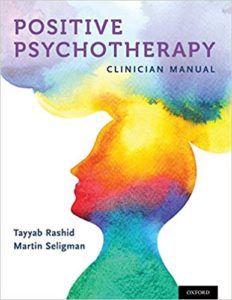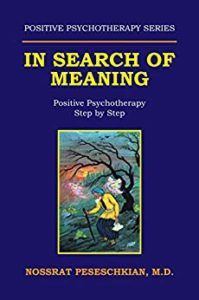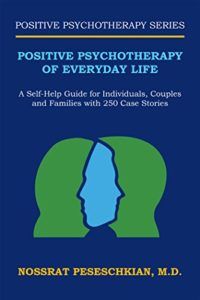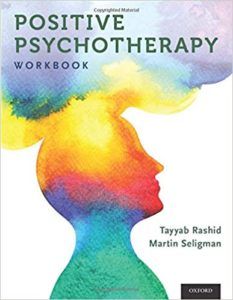What Is Positive Psychotherapy? (Benefits & Model)
 Seeking out any type of therapy can be daunting.
Seeking out any type of therapy can be daunting.
We often realize that we could benefit from external support slowly, and for many, taking the next step can be clouded by internal fears.
What will a therapist have to say about me and my behavior?
What shortcomings will they uncover and assign to me?
How will this change how I think and feel about myself?
All therapy should focus on cultivating positive aspects of a person and how they engage with the world and others around them. Through therapy they may start to uncover areas of growth and begin to move toward their full authentic potential.
Positive psychotherapy is one such therapeutic model. It focuses on supporting clients to use their inner resources to overcome challenges, understand and recognize areas of growth, and build resilience and a greater sense of wellbeing.
Before you continue, we thought you might like to download our three Positive Psychology Exercises for free. These science-based exercises explore fundamental aspects of positive psychology, including strengths, values, and self-compassion, and will give you the tools to enhance the wellbeing of your clients, students, or employees.
This Article Contains:
- What Is Positive Psychotherapy (PPT)?
- Nossrat Peseschkian’s Work and a Brief History of Positive Psychotherapy
- Five Benefits of Positive Psychotherapy
- How Does Positive Psychotherapy Relate to Positive Psychology?
- 3 Positive Psychotherapy Interventions
- The Positive Psychotherapy Model (inc. Table With Brief Session Descriptions)
- 18 Positive Psychotherapy Resources
- A Take-Home Message
- References
What Is Positive Psychotherapy (PPT)?
Positive psychotherapy (PPT) is a relatively new therapeutic approach, influenced by both the humanistic and psychodynamic approaches to diagnosis and treatment. Its core focus is on moving away from what’s ‘wrong’ with an individual and toward what’s good and positive.
Seligman, Rashid, and Parks (2006, p. 774) offer the following definition for PPT concerning depression:
Positive psychotherapy (PPT) contrasts with standard interventions for depression by increasing positive emotion, engagement, and meaning rather than directly targeting depressive symptoms.
While the emphasis is on positivity and positive outcomes, the overall theory of PPT also asserts that three core principles need to be addressed to allow this to happen (Dobiała & Winkler, 2016):
- Hope: This principle encourages focus on the overall positivity of humanity. Negative experiences are to be seen as having a higher purpose with a positive reframing. Therapists encourage clients to explore any disruptions to a sense of wellbeing and reframe them as signals that there is an imbalance that requires addressing.
- Balance: This principle examines how we experience discontent and the coping methods we use to address it. According to PPT, negative symptoms arise when these coping methods aren’t working and areas of our life are out of balance, with discontent impacting how we think and feel. Peseschkian (1979) ascertained there are four key areas where we experience imbalance: body/sense, achievement/activities, contact/environment, and fantasy/future. These are the areas PPT focuses on when exploring and addressing the principle of balance.
- Consultation: This principle sets out the five stages of therapy that must be worked through to achieve a positive outcome:
- Observation: The individual provides an account of the issues, challenges, or situations that are upsetting them and those that are making them happy.
- Inventory: The therapist and individual work together to explore and highlight the correlation between negative feelings/symptoms and the individual’s true capabilities.
- Situational support: The individual is asked to focus on their positive traits and those of the people around them who significantly offer them support.
- Verbalization: The individual is encouraged to talk openly about any negative feelings, challenges, or symptoms.
- Development of goals: The individual is invited to turn their focus to the future, set positive goals, and envision the positive feelings they want to cultivate, connecting these with their unique strengths.
Another core component of PPT is the emphasis it places on core capabilities. According to PPT theory, everyone has two core capabilities (Peseschkian, 1979):
- Perception: We can draw connections between the different areas of life.
- Love: We can develop complex and nuanced emotions and interpersonal relationships.
Peseschkian (1979) concluded that these two core capabilities form the foundation of our further abilities. PPT seeks to explore an individual’s core capabilities to better understand and, where appropriate, address imbalances to create additional positive outcomes.
Overall, PPT has been received very positively in the positive psychology community, with some wonderful outcomes and results.
Nossrat Peseschkian’s Work and a Brief History of Positive Psychotherapy
Although Seligman is considered one of the cofounders of PPT, similar therapies focusing on happiness or quality of life over negative experiences pre-date Seligman’s work.
Most notably is the work of Nossrat Peseschkian, a psychotherapist, psychiatrist, and neurologist who set up practice in Germany in the 1960s.
Influenced by humanist psychology, meetings with multiple influential psychologists and spiritual practitioners, as well as his own experiences working with clients across more than 20 cultures, Peseschkian wanted to create an integrative, culturally sensitive therapy model that focused on positive experiences.
In the 1970s, Peseschkian began to deliver lectures around his therapy model and published four books based on PPT during this time. In the early 1970s, Peseschkian referred to his model as ‘differentiation analysis.’
In 1977, he published his first book, Positive Psychotherapy, and in so doing, renamed his approach. During this time, PPT gained further recognition with structured training and the founding of the Psychotherapeutic Group of Wiesbaden, The German Association for Positive Psychotherapy, and the Journal of Positive Psychotherapy in 1979.
Through the 1980s and 1990s, PPT grew in its structure, uses, and recognition as a prevalent theory outside of Germany, with Peseschkian traveling to more than 60 countries to deliver talks and lectures, and opening more than 30 centers. He also continued to publish books, and the Wiesbaden Inventory for Positive Psychotherapy and Family Therapy was published in 1988.
In 1994, the International Center for Positive Psychotherapy opened its doors and later became the World Association for Positive Psychotherapy in 2008. The first effectiveness study of PPT was conducted between 1995 and 1997, concluding that PPT demonstrated a strong therapeutic influence for a range of mental health diagnoses (Peseschkian & Tritt, 1998).
Peseschkian wasn’t the only one to recognize the benefits of focusing on the positive in therapy. During this time, several other psychologists also explored similar concepts.
Fordyce (1977) developed a ‘Happiness’ intervention and worked with students to help them utilize a series of 14 tactics aimed at developing a better sense of wellbeing and happiness.
These tactics came with detailed instructions and included things such as socializing, engaging in meaningful work, deepening close relationships with loved ones, and managing expectations. Fordyce (1977) found that students who used the tactics and instructions reported being happier and showed fewer depressive symptoms than thise in a control group.
Alongside Peseschkian’s approach, Seligman has been responsible for developing the PPT model, integrating more contemporary notions of positive psychology. Where Peseschkian’s (1997) model is more integrative, cross-disciplinary, and focuses on multicultural concepts, modern PPT is primarily based on Seligman’s (2002) notion of happiness and wellbeing overall.
It’s important to acknowledge that while similar, there are some slight differences between the two approaches (see “How Does Positive Psychotherapy Relate to Positive Psychology?” below).
Five Benefits of Positive Psychotherapy
The primary goal of PPT is to help individuals better understand the skills and capabilities they do and do not have to achieve a greater sense of inner balance. This is achieved by exploring innate resources – physical, emotional, spiritual, and cognitive – that the individual already has and may need help tapping into in positive ways.
There are many benefits of positive psychotherapy and in approaching our mental health in this way. Below, I’ve explored the top five in more detail.
1. Empowers the individual
As PPT places a strong emphasis on helping the individual to examine their strengths, skills, and capabilities in a positive manner, it increases their sense of empowerment and control over the different areas of their life, as well as their capacity to handle challenges and negative experiences (Rashid, 2014).
The therapist’s role in the client–therapist relationship is to encourage the individual to uncover things on their own terms. It places the good with the bad, helping individuals find the balance they need to accept all parts of themselves.
This integration of skills, weaknesses, virtues, vulnerabilities, and strengths helps to build a more balanced perspective rather than reducing individuals to merely their symptoms or challenges.
2. Positive reframing of negative symptoms and a focus on balance
PPT brings the negative in line with the positive, bringing the two into alignment and balance.
This approach helps individuals to better understand their strengths and skills, where they might have gaps, and how these can perpetuate negative feelings or imbalances if not addressed appropriately.
3. Acknowledges and supports cultural transitions and differences
Because PPT encourages empowerment on the individual, it can help them to feel more in control across different areas of their life, even when it might feel that external circumstances are taking over. This has proven beneficial for individuals experiencing conflict in multicultural environments or relationships.
Huysse-Gaytandjieva and Bontcheva (2013) explored migration and the challenges faced by those who had moved to new countries and cultures. They found that those who applied positive psychotherapy techniques were better able to overcome these challenges, with two-thirds of participants reporting that depressive symptoms were entirely resolved.
4. Better management of expectations and therapy outcomes
PPT acknowledges the importance of the client–therapist relationship, and self-directed techniques are instrumental in helping individuals get the most out of the therapy (Rashid & Seligman, 2018).
With a greater awareness of personal capabilities, strengths, and skills, the individual can understand their mental health journey and how they can improve it. As a result, therapy expectations are better managed, and individuals see the outcome of PPT as being about more than merely the elimination of negative symptoms or feelings.
5. Proven to help a range of mental health conditions
With its focus on strengths and cultivation of the positive elements of life, PPT has shown to be highly beneficial across a range of mental health conditions including psychosis (Schrank et al., 2016), suicidal ideation (Johnson et al., 2010), depression (Seligman et al., 2006; Carver, Scheier, & Segerstrom, 2010) and borderline personality disorder (Uliaszek, Rashid, Williams, & Gulamani, 2016).
How Does Positive Psychotherapy Relate to Positive Psychology?
The two approaches sound very similar, and there are some cross-overs in how they tackle individual experiences within therapy. Positive psychology is popularly attributed as being the brain-child of Martin Seligman, developed in 1998; positive psychotherapy is more commonly attributed to Nossrat Peseschkian, first developed in 1968.
What are the similarities and differences between the two?
Both approaches emphasise personal development and the importance of tapping into innate resources and strengths to overcome challenges and negative emotions. Both also assume that we are all inherently good and need to work hard when external influences try to prevent us from becoming the best versions of ourselves.
There are also some slightly nuanced, but very essential, differences (Peseschkian, 2012):
| Positive psychotherapy | Positive psychology |
|---|---|
| Believes all negative experiences can be challenged and reframed in a positive way, as they are essentially opportunities for further growth. | Acknowledges negative experiences and emotions but doesn’t necessarily incorporate them in the same way. |
| Focuses more on multicultural experiences and the challenges that individuals can face across different cultures, both similar and different. | Has a more Eurocentric approach to therapy and an individual’s experiences. |
| Influenced equally by humanistic and psychodynamic approaches and seeks to integrate the best of both. | Less focused on humanistic models and therapies and less integrative of other psychological approaches. |
Seligman has spoken extensively about both approaches and how the two are related in specific ways, identifying that positive psychotherapy helps individuals to move past the process of suffering to uncover deeper insights about their wellbeing (Seligman & Wyatt, 2008).
While acknowledging negative or traumatic experiences is a core component of many therapeutic approaches, Seligman has acknowledged that positive psychotherapy does have a more positive focus when going through this process.
3 Positive Psychotherapy Interventions

The interventions utilized in PPT are varied and will often depend on what the individual expresses in the therapy sessions.
One distinct component of PPT interventions is how they incorporate imagination and intuition as part of the therapeutic process. Storytelling is another key way PPT encourages individuals to engage with their therapy journey, and this idea of building the self into the stories helps individuals to better articulate their journeys, experiences, challenges, and desires.
Through this process, PPT therapists can begin to introduce adjustments or dive deeper into sensitive topics without seeming to ‘attack’ the individual.
Therapists can also help those they work with to reframe their experiences and symptoms in positive ways, and create better balance. Once individuals can accept all aspects of themselves and begin to see negative experiences in a positive light, they generally no longer repeat those negative experiences (Tugade & Fredrickson, 2004).
The specific interventions used in this process focus on empowering the individual and providing them with the tools and resources to face up to negative or traumatic experiences, cultivate resilience, and develop better emotional functioning.
These include:
1. Practicing gratitude
Gratitude is a strong cognitive state, generally associated with the idea that you have achieved a personal benefit that wasn’t initially or intentionally sought after (Emmons & McCullough, 2003). Feeling gratitude can have a strong re-energizing impact on our emotional wellbeing and has been shown to lead to greater feelings of happiness and healing.
In therapy, practicing gratitude can begin with making the time to acknowledge all the small everyday things that we are grateful for. Gratitude journals, worksheets, and resources are widely available, showing individuals everything they have in their lives to feel grateful for – something many of us often forget to acknowledge – is a popular intervention in PPT.
2. Practicing forgiveness
Forgiveness – for ourselves, others, and general experiences – can be a vital part of healing and promoting a greater sense of wellbeing. Worthington (2003) proposed two core types of forgiveness within clinical/therapy settings:
- Decisional forgiveness: when the individual states a behavioral intent to forgive.
- Emotional forgiveness: when the individual has true emotional acceptance of the situation, experience, or personal feelings that require forgiveness.
We can utilize decisional forgiveness but still feel emotionally upset, which can lead to further unforgiveness and negative symptoms related to our mental health (Worthington & Scherer, 2004). PPT utilizes the practice of forgiveness as a key intervention, particularly focusing on emotional forgiveness, so that individuals feel a complete sense of healing when moving past negative symptoms.
3. Practicing empathy
The PPT approach teaches that all humans are inherently good and innately want to live meaningful lives and have enriching relationships. Empathy is a core component of this, but it has been shown to routinely fail as an innate ability in several challenging or conflicting scenarios (Zaki & Cikara, 2015).
Most empathy-related interventions build on the notion that we are all capable of empathy, and these interventions support individuals to focus instead on developing their ability to tap into empathy and target it in specific ways.
One approach used by PPT is storytelling, which asks individuals to put themselves in another’s shoes and describe how they might feel, react, or respond to challenging and positive situations.
The Positive Psychotherapy Model (inc. Table With Brief Session Descriptions)
Similar to other therapy models, the PPT model focuses on a series of sessions aimed at uncovering ideas, desires, vulnerabilities, and strengths, and working through them to reach positive reframing and overall balance.
This outline of sessions is a brief overview of the PPT model. Some versions of this relate more to the approach developed by Peseschkian. As with all therapy models, there can be slight nuances depending on the therapist and where/how they practice.
| Session and topic | Description |
|---|---|
| Orientation to PPT; Current positive resources | Psychological distress is discussed as a lack of positive resources, such as positive emotions, relationships, meaning, and accomplishment. To explore this, the therapist might use an exercise that encourages the individual to write a one-page, real-life story that called for the best in them and has a positive ending. |
| Individual character strengths | In this session, individual character strengths are explored, and the concept of engagement and flow is introduced. To begin exploring individual character strengths, the individual may be asked to identify their signature strengths both in the session and through an online self-report. They may also ask two loved ones to rate their signature strengths. |
| Signature strengths & positive emotions | Following on from the last session, signature strengths are discussed in more detail. As an exercise, the therapist may ask the individual to compile a signature strengths profile, which could include setting SMART (specific, measurable, achievable, realistic, and timely) goals. |
| Good vs. bad experiences, symptoms, or memories | The concept of how negative experiences and symptoms can be perpetuated is discussed in alignment with positive experiences. The therapist might ask the individual to explore a memory or experience that elicited feelings of anger, bitterness, or resentment and how these feelings further perpetuated the negative experience. |
| Forgiveness | Forgiveness is explored as a resource to reframe negative symptoms and feelings into more positive emotions. The therapist might use a letter-writing exercise that asks the participant to remember a negative experience and write out a letter of forgiveness toward the perceived transgressor. |
| Gratitude | Alongside forgiveness, gratitude is explored as a resource for generating better balance and viewing individual circumstances more positively. The role of positive and negative memories, feelings, and symptoms is discussed with an emphasis on gratitude for all the lessons both of these states have allowed for. The therapist might use gratitude journaling as an exercise to help build more focus and awareness of all the things for which the individual is grateful. |
| Mid-therapy check | At this point, the therapist may follow up on any at-home tasks related to the forgiveness and gratitude sessions, and revisit any of the previous sessions that may feel unresolved. This is also the opportunity for the individual to discuss their perceived gains or hurdles. As an exercise, the therapist may seek to explore different ways the individual can overcome any of the hurdles, utilizing their signature strengths. |
| Satisficing vs. maximizing | The therapist may now introduce the two concepts of satisficing (mainly, being ‘good enough’) and maximizing. The individual may be asked to explore the different ways in life they have not felt ‘good enough’ telling a story about a time they didn’t feel good enough and one when they did. Again, these can be explored regarding the individual’s signature strengths. |
| Hope and optimism | The additional concepts of optimism and hope are explored. As an exercise, the therapist may ask the individual to think about a time when they felt they lost out on something, only to discover it opened up new opportunities. |
| Positive communication | Various interventions that involve developing positive communication, such as active-constructive, are explored and referenced in association to the individual’s signature strengths. |
| Signature strengths of others | The importance of recognizing, acknowledging, and associating with other’s signature strengths is explored. As an exercise, the therapist may ask the individual to draw up a ‘Family Strengths Tree.’ The individual asks the significant people in their life to identify their signature strengths. These can then be discussed in the session. |
| Savoring | The concept of savoring is explored, as well as some of the techniques and strategies that can be used to prevent and safeguard against hedonic, aka, the hedonic treadmill. |
| Gift of time and positive legacy | The benefits of kindness, sharing, and helping others are explored and discussed in alignment with therapeutic outcomes. As an exercise, the therapist might ask the individual to make plans for how they might give their time utilizing their signature strengths. |
| The full life | In the final session, ‘the full life’ is discussed in terms of what the individual feels they have that leads to this. Therapeutic gains are discussed, focusing on positive emotions, engagement, and meaning. How to keep this momentum going is also discussed, and ways of doing this are devised with the individual taking the lead and considering their signature strengths to achieve this. |
The table above is a brief overview of the sessions that can be included in the PPT model. If you’d like to find out more about the model and detailed descriptions of the sessions, as well as interventions and positive psychotherapy exercises that can be used within them, you can find more information through the Positive Psychology Toolkit©.
18 Positive Psychotherapy Resources
As a psychological approach, PPT has grown considerably in popularity over the past decade or so. There is now a wide range of resources, tools, books, and other media to help you better understand this model and utilize it in productive ways.
Below, I’ve listed some of the resources I’ve found during my research on the topic that you might also find beneficial
5 Books on positive psychotherapy
1. Positive Psychotherapy: Clinician Manual – Tayyab Rashid and Martin Seligman

It includes a detailed and accessible write-up of the theories and research that underpin PPT, alongside best practices and inspiring case studies.
Available on Amazon.
2. In Search of Meaning: Positive Psychotherapy Step by Step – Nossrat Peseschkian

Available on Amazon.
3. Positive Psychotherapy of Everyday Life: A Self-Help Guide for Individuals, Couples and Families with 250 Case Stories – Nossrat Peseschkian

It also includes a wide range of case studies that many may find useful.
Available on Amazon.
4. Positive Psychotherapy Workbook – Tayyab Rashid and Martin Seligman

Available on Amazon.
5. Savoring: A New Model of Positive Experience – Fred Bryant and Joseph Veroff

Available on Amazon.
3 Podcast episodes on positive psychology and positive psychotherapy
Below is a selection of podcast episodes that further explore PPT, positive psychology, and some of the core concepts that PPT encapsulates:
- Live Happy Podcast: How to Banish Negative Thoughts with Ora Nadrich. Access here.
- Greater Good Center: Why Gratitude Works with Christine Carter and Rona Renner. Access here.
- Being Well Podcast: Forgiveness with Dr. Rick Hanson. Access here.
5 Videos on positive psychotherapy
These videos are fantastic resources for further developing an understanding of some of the core ideals and concepts that formulate PPT approaches.
1. TEDx – The New Era of Positive Psychology – Martin Seligman
2. The Art of Charm on YouTube – Positive Psychology & the Science of Wellbeing with Rob Mack
3. TEDx – Why Forgiveness Is Worth It – Sarah Montana
4. TEDx – The Hidden Power in a Breath of Gratitude – Roy Ledbetter
5. TEDMED – The Positive Effects of Positive Emotions – Jennifer Stellar
5 Downloadable positive psychotherapy resources
Below is a selection of downloadable resources, worksheets, and toolkits offering guidance on a range of PPT practices and approaches.
1. Develop Good Habits – 90-Day Gratitude Journal
This comprehensive little journal includes 90 tips, anecdotes, guidance, and exercises to help you incorporate more gratitude into every day. It’s perfect for those who want to practice more gratitude but are unsure how or where to start.
2. ‘Three Good Things’ Gratitude Journal Worksheet
Another gratitude focused worksheet, Three Good Things is a very common exercise utilized within PPT. This free downloadable worksheet offers prompts to meditate on the specific things that have happened during your day, week, or month for which you are grateful.
3. The Path of Forgiveness – Forgiveness Workbook
This extremely comprehensive workbook is a fantastic source of information, guidance, and exercises to help you better understand how forgiveness plays an active role in your perceptions and relationships, for good or bad. It’s detailed, thoughtful, and can help you develop a better and healthier practice of forgiveness.
4. Short Exercises for Understanding Empathy Worksheet
This quick and easy-to-use Understanding Empathy worksheet is aimed at students, to help them discern what empathy is, and how it looks in different situations. After watching a video, reflective questions are asked and role play used to see how the use of empathy would affect a situation.
5. Increasing Empathy: Empathy Training Manual
This is a more in-depth and comprehensive workbook exploring empathy. It includes details of what empathy is, how it has been explored in different contexts, and short exercises to use individually or as a coach to further develop empathy.
A Take-Home Message
I hope this article has provided an in-depth and balanced perspective of PPT, what it can do for individuals, and how the model can be beneficial in a range of mental health settings.
As someone who travels extensively and interacts with a range of cultures, I’ve found exploring the topic extremely beneficial for me personally. As a model that embraces multicultural approaches to challenges we might all experience, it’s one I’ll be coming back to during my work and studies.
If there’s one thing I’d like you to take away from reading this article, it’s how PPT offers a balance of the positive and negative we all experience in our daily lives.
Positive psychology is all about bringing better understanding and balance across the many different spheres we exist in. If you’re sensing an imbalance, PPT could be a great approach to explore and help you better understand the where, what, why, and how to address that imbalance.
We hope you enjoyed reading this article. Don’t forget to download our three Positive Psychology Exercises for free.
- Bryant, F. B., & Veroff, J. (2006). Savoring: A new model of positive experience. Psychology Press.
- Carver, C. S., Scheier, M. F., & Segerstrom, S. C. (2010). Optimism. Clinical Psychology Review, 30(7), 879–889.
- Dobiała, E., & Winkler, P. (2016). ‘Positive psychotherapy’ according to Seligman and ‘positive psychotherapy’ according to Peseschkian: A comparison. International Journal of Psychotherapy, 20(3), 5–17.
- Emmons, R. A., & McCullough, M. E. (2003). Counting blessings versus burdens: An experimental investigation of gratitude and subjective well-being in daily life. Personality & Social Psychology, 88, 377–389.
- Fava, G. A. (1999). Well-being therapy: Conceptual and technical Issues. Psychotherapy and Psychosomatics, 68, 171–179.
- Fava, G. A., & Ruini, C. (2003). Development and characteristics of a well-being enhancing psychotherapeutic strategy: Well-being therapy. Journal of Behavior Therapy and Experimental Psychiatry, 34(1), 45–63.
- Fordyce, M. W. (1977). Development of a program to increase personal happiness. Journal of Counseling Psychology, 24(6), 511–521.
- Huysse-Gaytandjieva, A., & Bontcheva, I. (2013). Why do we fail to adapt to a different culture? A development of a therapeutic approach. International Journal of Psychotherapy, 17(3).
- Johnson, J., Gooding, P. A., Wood, A. M., Taylor, P. J., Pratt, D., & Tarrier, N. (2010). Resilience to suicidal ideation in psychosis: Positive self-appraisals buffer the impact of hopelessness. Behaviour Research and Therapy, 48, 883–889.
- Peseschkian, N. (1979). In search of meaning: Positive psychotherapy step by step. Springer.
- Peseschkian, N. (2012). Positive psychotherapy: Theory and practice of a new method. Springer Science & Business Media.
- Peseschkian, N. (2016). Positive psychotherapy of everyday life: A self-help guide for individuals, couples and families with 250 case stories. AuthorHouse UK.
- Peseschkian, N., & Tritt, K. (1998). Positive psychotherapy effectiveness study and quality assurance. The European Journal of Psychotherapy, Counselling & Health, 1(1), 93-104.
- Rashid, T. (2014, June 11). Positive psychotherapy: Using strengths to promote balance. GoodTherapy. Retrieved from https://www.goodtherapy.org/blog/positive-psychotherapy-using-strengths-to-promote-balance-0611145
- Rashid, T., & Seligman, M. E. P. (2018). Positive psychotherapy: Clinician manual. Oxford University Press.
- Rashid, T., & Seligman, M. E. P. (2019). Positive psychotherapy: Workbook. Oxford University Press.
- Schrank, B., Brownell, T., Jakaite, Z., Larkin, C., Pesola, F., Riches, … Slade, M. (2016). Evaluation of a positive psychotherapy group intervention for people with psychosis: Pilot randomised controlled trial. Epidemiology and Psychiatric Sciences, 25(3), 235–246.
- Seligman, M. E. P. (2002). Authentic happiness: Using the new positive psychology to realize your potential for lasting fulfillment. Free Press.
- Seligman, M. E. P., Rashid, T., & Parks, A. C. (2006). Positive psychotherapy. American Psychologist, 61(8), 774.
- Seligman, M. E. P., & Wyatt, R. C. (2008). Positive psychology and psychotherapy with Martin Seligman (Individual Version). [DVD]. Distributed by Psychotherapy.net.
- Tugade, M. M., & Fredrickson, B. L. (2004). Resilient individuals use positive emotions to bounce back from negative emotional experiences. Journal of Personality and Social Psychology, 86(2), 320–333.
- Uliaszek, A. A., Rashid, T., Williams, G. E., & Gulamani, T. (2016). Group therapy for university students: A randomized control trial of dialectical behavior therapy and positive psychotherapy. Behaviour Research and Therapy, 77, 78–85.
- Worthington, E. L., Jr. (2003). Forgiving and reconciling: Bridges to wholeness and hope. InterVarsity Press.
- Worthington, E. L. Jr., & Scherer, M. (2004). Forgiveness is an emotion focused coping strategy that can reduce health risks and promote health resilience: Theory, review, and hypotheses, Psychology and Health, 19(3), 385–405.
- Zaki, J., & Cikara, M. (2015). Addressing empathic failures. Current Directions in Psychological Science, 24(6), 471–476.
Let us know your thoughts
Read other articles by their category
- Body & Brain (49)
- Coaching & Application (57)
- Compassion (26)
- Counseling (51)
- Emotional Intelligence (24)
- Gratitude (18)
- Grief & Bereavement (21)
- Happiness & SWB (40)
- Meaning & Values (26)
- Meditation (20)
- Mindfulness (45)
- Motivation & Goals (45)
- Optimism & Mindset (34)
- Positive CBT (28)
- Positive Communication (20)
- Positive Education (47)
- Positive Emotions (32)
- Positive Leadership (18)
- Positive Parenting (4)
- Positive Psychology (33)
- Positive Workplace (37)
- Productivity (16)
- Relationships (46)
- Resilience & Coping (36)
- Self Awareness (21)
- Self Esteem (37)
- Strengths & Virtues (31)
- Stress & Burnout Prevention (34)
- Theory & Books (46)
- Therapy Exercises (37)
- Types of Therapy (64)






What our readers think
What is the difference then between positive psychotherapy and coaching?
Hi Abby,
Great question! There are several differences between psychotherapy and coaching. One of the main differences regards the accreditation. In order to become a psychotherapist, one must have a degree in Psychology and a specific license to practice. Coaches do not need to undergo formal education, yet most coaches do participate in some form of coaching training. Another main difference is that psychotherapists are trained to help treat mental illness and make a diagnosis, and coaches are not. Coaches focus more on broader aspects in your life that you wish to improve (e.g., organizational skills, time management, dealing with deprecating thoughts, etc.)
I hope this helps 🙂
Kind regards,
-Caroline | Community Manager
As this article rightfully points out, there are two different and unrelated approaches. (1) Positive Psychotherapy by Nossrat Peseschkian, and (2) Positive Psychotherapy by Seligman and Rashid. Although these two approaches have the same name, there is no relationship between the two; there is not one, but two forms of positive psychotherapy. It’s important not to confuse the two.
Very Useful. Thank You Very Much!
I have research in the feild. Very help full your article thank you so much
I was very impressed by your article. Thank you.
I am also interested in behavioural coaching and mentoring.